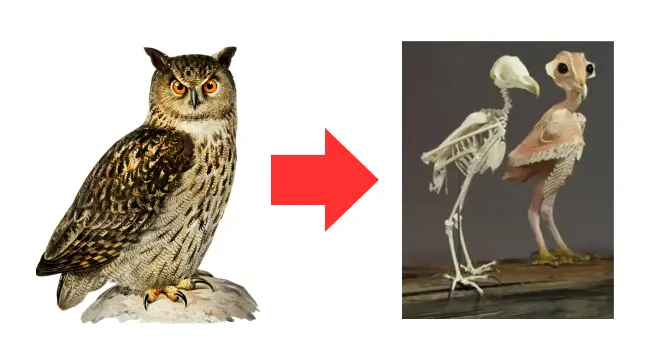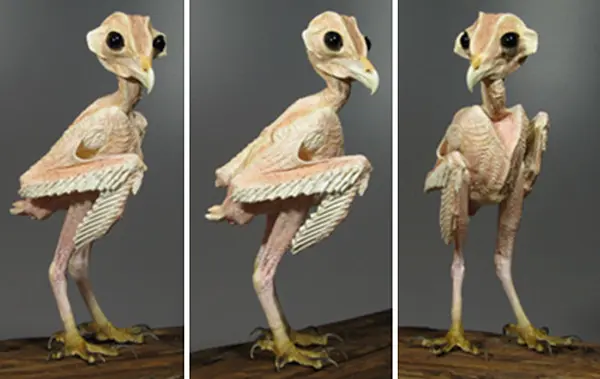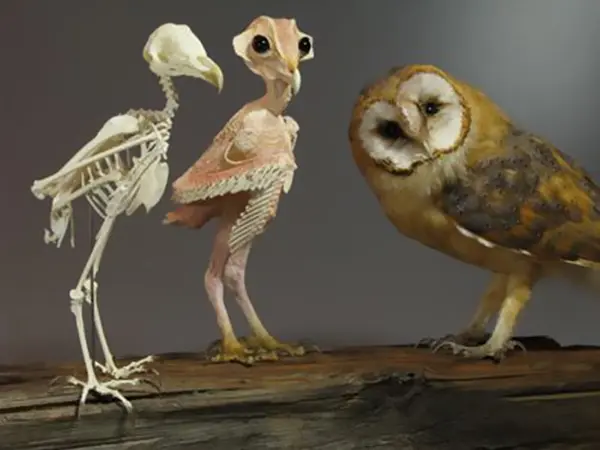
Owls are amazing creatures of the night, famous for their mysterious look and quiet flight. But have you ever thought about what they look like without their soft feathers? In this article, we’ll take a closer look at owls without feathers, exploring their unique bodies and why they might appear featherless. From their lightweight bones that help them fly silently to the cool features that make them great hunters, we’ll uncover what makes these birds so special. Get ready to discover the hidden side of owls without feathers—a side most people have never seen!
Owls Without Feathers: A Rare and Fascinating Phenomenon
Owls are known for their majestic look, quiet flight, and soft feathers that keep them warm. But have you ever wondered what an owl looks like without feathers? Featherless owls are rare, but they show a fascinating side of these mysterious birds that few people get to see. In this article, we’ll talk about why owls lose their feathers, what they look like without them, and how they are cared for in special rehabilitation centers.
Why Are Featherless Owls Important?
Featherless owls give us a chance to learn more about how these birds survive and adapt. Feathers are very important for keeping owls warm, helping them fly silently, and hiding them from predators. Seeing an owl without feathers shows us just how much they rely on their plumage to survive.
Featherless owls may look strange, but they help us understand the amazing design and abilities of these birds. Whether caused by health issues or natural processes, seeing an owl without feathers is a rare and fascinating experience.
This version uses simpler language and shorter sentences to make it easier for younger readers to understand while keeping the information engaging and informative!
Dana Schwartz posted an astonishing image of a featherless owl:


Next, she drew a fascinating comparison between the featherless owl, a fully feathered counterpart, and the intricate framework of an owl’s skeleton.


Why Do Owls Lose Their Feathers?
Owls don’t usually lose their feathers, but when it happens, it can cause big problems for them. Feathers are super important because they keep owls warm, help them blend into their surroundings, and allow them to fly silently. Without feathers, owls become vulnerable to predators, bad weather, and trouble hunting. Here are the main reasons why owls might lose their feathers:
1. Genetic Mutations
Sometimes, owls are born with rare genetic conditions that stop their feathers from growing properly. These conditions can cause bald spots or even leave an owl completely featherless. This is more common in captive owls than wild ones. Without feathers, owls struggle to stay warm and hidden from predators.
2. Injuries or Illnesses
Injuries like cuts or wounds can damage an owl’s feathers or skin, causing them to fall out. Illnesses such as fungal infections or infestations by feather mites can also destroy feathers. Some diseases prevent feathers from growing back properly, leaving the owl with patchy plumage.
3. Stress and Malnutrition
Stress from habitat destruction or human interference can mess up an owl’s feather growth cycle. Poor nutrition is another problem—if an owl doesn’t get enough vitamins or protein, its feathers may become weak and fall out.
4. Molting Problems
Molting is a natural process where owls shed old feathers to grow new ones. But if an owl is sick or stressed during molting, it might lose too many feathers at once or struggle to grow new ones quickly enough.
5. Parasites
Parasites like mites or lice can attack an owl’s feathers, causing them to break or fall out. Severe infestations can leave the owl featherless and in need of medical care.
How Feather Loss Affects Owls
When owls lose their feathers, they face serious challenges:
- Staying Warm: Feathers keep owls warm during cold nights. Without them, they can get too cold and sick.
- Hiding from Predators: Feathers help owls blend into their surroundings. Losing them makes it harder for owls to stay hidden.
- Flying Silently: Owls need smooth feathers to fly quietly while hunting prey. Missing feathers make flying noisy and difficult.
Helping Featherless Owls
Owls that lose their feathers often need special care:
- Medical Treatment: Vets treat infections, injuries, or parasites that cause feather loss.
- Safe Environment: Featherless owls are kept in warm shelters to protect them from bad weather and predators.
- Feather Regrowth: In most cases, healthy feathers grow back once the owl recovers. If not, experts may use techniques like attaching replacement feathers.
Feather loss in owls is rare but serious. It can happen because of genetics, injuries, illness, stress, or parasites. By understanding why it happens and how rehabilitation centers care for affected owls, we can help these amazing birds recover and thrive—whether they’re in the wild or under human care.
The Role of Feathers in an Owl’s Survival
Feathers are very important for an owl’s survival. They keep the owl warm on cold nights and help it blend into its surroundings to stay hidden. Feathers also allow owls to fly silently, which is crucial for hunting. Without feathers, owls lose these important abilities, making it very hard for them to survive in the wild.
What Does an Owl Without Feathers Look Like?
Seeing an owl without feathers is an unusual and rare experience. These birds look very different from their feathered counterparts, and imagining what they might look like is both surprising and fascinating.
Exposed Skin
The most noticeable feature of a featherless owl is its bare skin. Instead of soft feathers, its body shows naked skin that can range in color from light pink to gray. The skin often looks wrinkled and slightly see-through, giving the owl a very unique appearance.
Enhanced Facial Features
Without feathers, the owl’s face stands out more. Its sharp, hooked beak becomes fully visible, making it look even more powerful. The owl’s large, round eyes remain captivating and seem even more striking without feathers surrounding them.
Slimmer Body
Feathers make owls look bigger and fluffier, but without them, their slim body shape becomes clear. This gives featherless owls a leaner and more streamlined appearance.
Exposed Talons
Owls are known for their strong claws, which they use to hunt and grip prey. Without feathers covering them, these talons are fully exposed and show just how powerful these hunting tools really are.
A Different Perspective
Seeing an owl without feathers can feel humbling. Feathers help owls stay warm, fly silently, and protect them from bad weather. Without them, these majestic birds appear more fragile and less regal than usual, reminding us of how important feathers are to their survival.
This version uses simple language and shorter sentences to make the content easier for younger readers to understand while keeping it informative and engaging.
Types of Featherless Owls
Owls without feathers are very rare, but they give us a fascinating look at what these birds look like underneath their soft plumage. While no owl species is naturally featherless, some owls lose their feathers because of injuries, illnesses, or other problems. Let’s explore some examples of owls that have been seen without feathers.
1. Barn Owl Without Feathers
Barn Owls are famous for their heart-shaped faces and graceful looks. But when they lose their feathers, they look very different. Their thin bodies and large heads become much more noticeable, giving them an unusual appearance. Photos of featherless Barn Owls have gone viral online, showing how important feathers are to their iconic look. Feather loss in Barn Owls can happen because of injuries, infections, or problems with molting.
2. Great Horned Owl Without Feathers
The Great Horned Owl is known for its strong body and ear tufts that look like horns. Without feathers, this owl’s muscular body and sharp talons stand out even more. While no real photos of featherless Great Horned Owls exist, experts believe they would look much slimmer and less fluffy. Feather loss in this species can be caused by stress, poor diet, or parasites.
3. Great Gray Owl Without Feathers
The Great Gray Owl is one of the largest owl species, but most of its size comes from its thick feathers. Without them, this owl looks much smaller and thinner than you’d expect. Its long legs and lightweight body become visible, showing how much its feathers add to its size. Feather loss in Great Gray Owls may happen due to stress or issues during molting.
4. Cuban Bare-Legged Owl
The Cuban Bare-Legged Owl is not completely featherless, but it has bare legs with little to no feathers covering them. This makes it stand out from other owl species. Found in Cuba, this owl has adapted well to its environment despite its unusual bare-legged appearance.
FAQ
Can hairless owls fly?
No, hairless owls cannot fly. Feathers are essential for flying because they provide lift and keep the owl warm. Without feathers, owls can’t stay in the air or control their body temperature, which makes flying impossible.
Which owl cannot fly?
The kakapo, also called the “owl parrot,” is a flightless bird that is active at night. It’s not actually an owl, but its owl-like face and ability to climb trees gave it the nickname. The kakapo is the only flightless parrot in the world and is native to New Zealand.
Can owls fly yes or no?
Yes, owls can fly. Most owls fly quietly and more slowly than other birds of prey, which helps them hunt at night. Their silent flight allows them to sneak up on prey that is listening for sounds in the dark.
What would an owl look like without feathers?
An owl without feathers would look very different. It would have long legs, a thin body, big eye sockets, and a noticeable beak. Feathers are important for their familiar look and ability to fly, so without them, owls look more bony and less like the birds we recognize.
Are there birds without feathers?
No, all birds naturally have feathers. Feathers are important for flying, staying warm, and helping birds look like their species. Sometimes, birds lose feathers because of diseases like avian baldness, but this isn’t normal. Even flightless birds like penguins and ostriches have feathers to keep warm and for display purposes.
How rare is it to see a great horned owl?
Great horned owls are common, but they’re hard to spot. They are active at night and have excellent camouflage, making them blend into trees easily. Seeing one takes patience and a bit of luck since they mostly hunt at night and stay hidden during the day.



